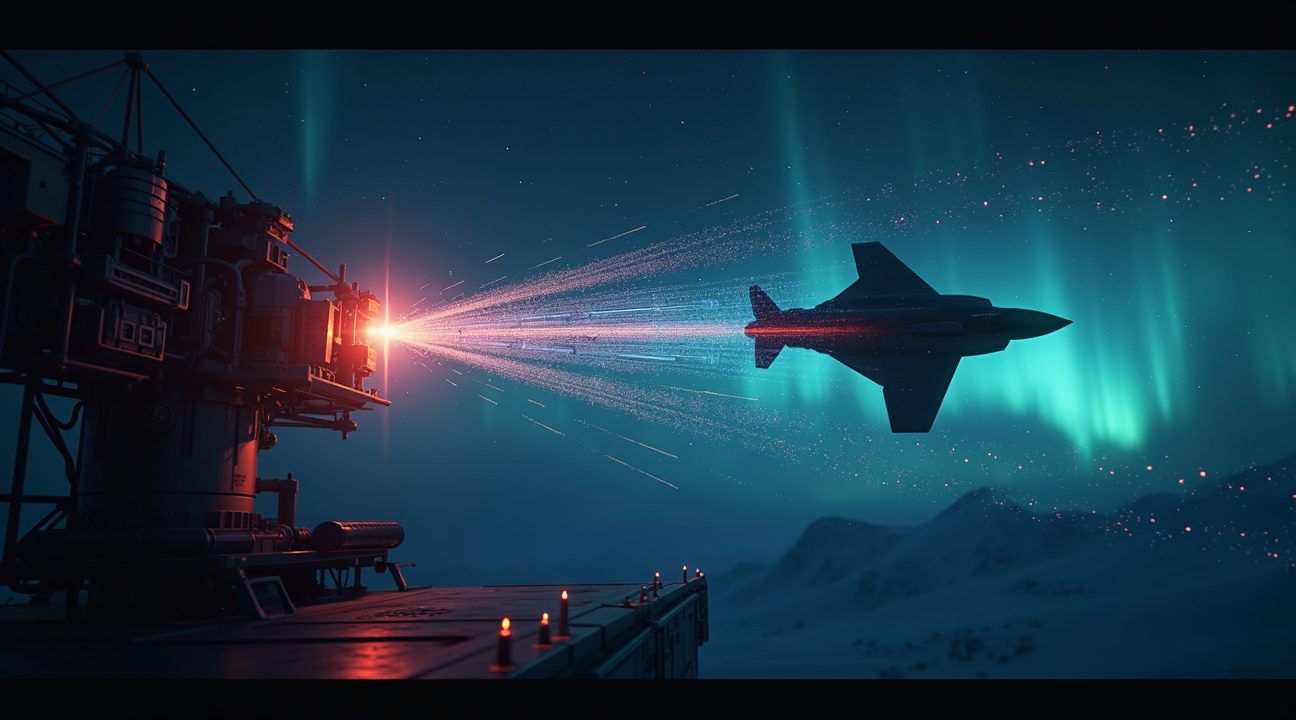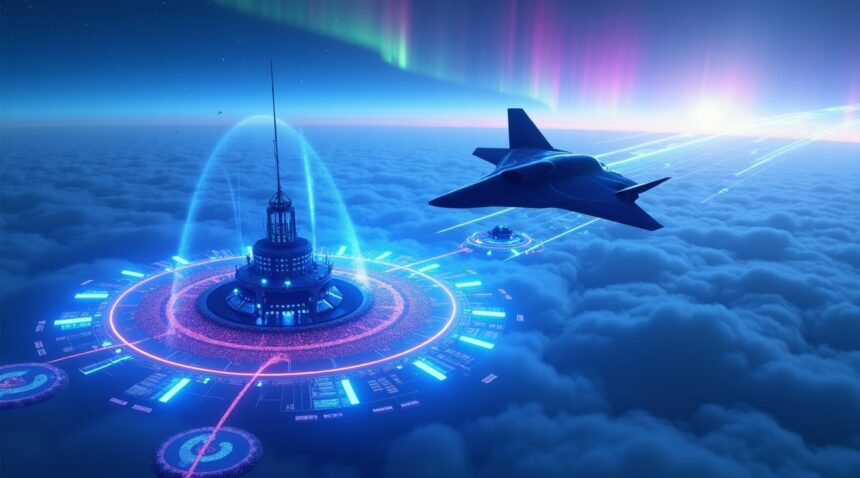Quantum radar technology represents a revolutionary breakthrough that exploits quantum entanglement to detect stealth aircraft without emitting detectable signals, making conventional stealth countermeasures obsolete.
Key Takeaways
- Quantum radar operates through entangled photon pairs, with one photon remaining at the detection system while its partner probes targets, eliminating the need for high-powered signal transmission that alerts aircraft to detection.
- Stealth aircraft remain completely unaware they face tracking since quantum radar produces no detectable electronic signatures that conventional radar warning systems can identify.
- The technology performs optimally at medium ranges around 600 kilometers, outperforming traditional radar systems, but loses effectiveness at distances beyond 1800 kilometers.
- Technical challenges including quantum decoherence, cryogenic cooling requirements, and maintaining entanglement across operational distances currently prevent widespread deployment.
- Beyond military applications, quantum radar shows promise for air traffic control, weather monitoring, terrain mapping, and autonomous vehicle guidance in environments where conventional radar struggles.
Canadian researchers at the University of Waterloo and Chinese military programs have developed working prototypes capable of identifying stealth targets under challenging conditions where traditional radar systems fail completely. This innovation could significantly shift the balance in radar surveillance and stealth technology development in the years to come.
Quantum Radar Makes Stealth Aircraft “Unaware They Have Been Detected”
I see quantum radar as a game-changing technology that fundamentally alters how we detect stealth aircraft. Traditional radar systems emit powerful radio signals and wait for reflections, which gives stealth aircraft their primary advantage since they’re specifically engineered to absorb or deflect these conventional signals. Quantum radar operates on an entirely different principle that renders these stealth countermeasures ineffective.
How Quantum Entanglement Revolutionizes Detection
The core innovation lies in quantum entanglement, where photon pairs share an instantaneous connection regardless of distance. I understand this technology creates entangled photon pairs where one photon (called the idler) remains with the quantum radar system while its partner (the probe photon) travels toward potential targets. This approach eliminates the need for high-powered signal transmission that typically alerts aircraft to their detection.
When the probe photon interacts with objects in the environment and returns, the quantum radar examines the correlations between the returning photon and its entangled partner. These quantum correlations create a unique signature that stealth materials and geometric designs cannot mask or eliminate. The quantum radar cross section (QRCS) provides fundamentally different information than traditional radar cross section (RCS) measurements, making conventional stealth technologies ineffective against this detection method.
Stealth Aircraft Remain Completely Unaware
The most significant advantage I observe is that quantum radar operates through quantum sensing principles that don’t require detectable signal emissions. Since no high-powered radio waves are transmitted, stealth aircraft cannot detect the radar system’s operation through their electronic warfare suites or radar warning receivers. This creates a scenario where advanced aerospace technology meets quantum physics in unexpected ways.
Detection probability increases substantially because quantum correlations persist even when conventional radar signals would be completely absorbed by stealth coatings. The non-classical radar approach bypasses the fundamental principles that stealth aircraft rely upon for concealment. I find this particularly important since it means that decades of stealth technology development focused on defeating traditional radar becomes obsolete against quantum detection systems.
The practical implications extend beyond military applications, as quantum radar could revolutionize air traffic control and aerospace safety measures. Unlike traditional systems that create electronic signatures detectable by sophisticated aircraft, quantum radar maintains complete operational stealth while providing superior detection capabilities. This represents a fundamental shift in the detection versus concealment paradigm that has dominated aerospace technology development.
https://www.youtube.com/watch?v=lD08zz0vhdE
How Quantum Radar Penetrates Stealth Technology That Conventional Systems Cannot
Stealth aircraft achieve their invisibility through sophisticated engineering that reduces conventional radar signatures by as much as 1000-fold. These aircraft employ radar-absorbent materials and carefully designed aerodynamic structures like flying-wing configurations to scatter or absorb incoming radar waves. Traditional radar systems depend heavily on the strength of reflected signals, making them vulnerable to these advanced stealth countermeasures.
Quantum radar operates on fundamentally different principles that bypass these conventional limitations. Rather than relying solely on return signal power, quantum radar systems compare received photon data with their entangled counterparts. This quantum entanglement creates an unbreakable connection between transmitted and reference photons, allowing the system to detect even minimal numbers of returned photons buried within environmental noise.
Superior Performance in Challenging Environments
The quantum approach maintains effectiveness even when facing electronic countermeasures that would cripple traditional systems. Environmental interference from geomagnetic storms and solar flares, which typically degrade conventional radar performance, has minimal impact on quantum radar detection capabilities. This resilience stems from the quantum correlation between entangled photons, which remains intact regardless of external electromagnetic disturbances.
Space exploration continues to push technological boundaries, as seen in recent developments like SpaceX missions that demonstrate advanced detection systems. Similarly, quantum radar represents a paradigm shift in detection technology.
Quantum Radar Cross Section Advantages
The quantum radar cross section (QRCS) provides a critical advantage over conventional radar cross section measurements. Traditional radar systems perform optimally only when targets are positioned at specific incident angles, creating blind spots that stealth aircraft can exploit. QRCS measurements show less dependence on target orientation or angle, eliminating many of these detection gaps.
This angular independence means quantum radar can identify stealth objects regardless of their positioning relative to the detection system. The technology’s ability to extract meaningful data from minimal photon returns, combined with its resistance to interference, positions quantum radar as a game-changing development in stealth detection capabilities. Unlike previous systems that struggled with stealth countermeasures, quantum radar’s fundamental operating principles make it inherently resistant to existing stealth technologies.

Range Performance: Where Quantum Radar Excels and Where It Falls Short
I’ve observed that quantum radar technology demonstrates remarkable capabilities within specific operational parameters, though it faces distinct limitations at extended ranges. The system achieves its peak performance at medium distances, delivering detection probability near 0 dB at approximately 600 kilometers—a range where it consistently outperforms traditional radar systems.
This sweet spot around 600 km represents the technology’s current optimal operating zone. Within this range, quantum radar leverages its unique quantum entanglement properties to maintain signal coherence and detection accuracy that surpasses conventional alternatives. The physics behind this performance stems from the system’s ability to correlate quantum-entangled photons without relying on high-power signal transmission.
Performance Limitations at Extended Distances
However, I must note that quantum radar’s effectiveness diminishes significantly at longer operational distances. At ranges extending to 1800 kilometers, conventional radar systems regain their performance advantage over quantum alternatives. This limitation reflects current technological constraints in maintaining quantum coherence across vast distances, where environmental factors and quantum decoherence begin to overwhelm the system’s inherent advantages.
Despite these range limitations, quantum radar offers compelling advantages in challenging operational environments. Its resistance to interference from geomagnetic storms and solar flares provides consistent performance when space weather conditions would typically degrade traditional radar systems. Additionally, the technology’s immunity to electronic jamming creates significant tactical advantages in contested environments where adversaries attempt to disrupt detection capabilities.
These resilience characteristics make quantum radar particularly valuable in scenarios requiring high sensing fidelity regardless of external interference. Military applications benefit from this reliability, especially when operating in environments where space-based systems might experience disruption. The technology’s passive detection approach means it doesn’t broadcast signals that can be detected or jammed by hostile forces.
Currently, quantum radar operates most effectively over distances up to several hundred kilometers, making it ideal for regional defense applications rather than long-range surveillance missions. This range profile suits coastal defense, border monitoring, and tactical battlefield awareness where medium-range detection with high reliability proves more valuable than extended-range capability with potential interference vulnerabilities.
The technology’s resistance to environmental interference positions it as a complementary system rather than a complete replacement for existing radar infrastructure. Advanced aerospace applications continue exploring ways to extend quantum radar’s effective range while maintaining its interference-resistant properties.

Technical Challenges Preventing Widespread Deployment
Quantum radar faces several formidable technical barriers that prevent its transition from laboratory prototype to operational defense system. I’ve observed how these challenges span from fundamental quantum physics limitations to complex engineering requirements that demand breakthrough solutions.
Quantum Entanglement Preservation Issues
The most critical obstacle lies in maintaining quantum entanglement across the distances required for practical radar applications. Quantum states exhibit extraordinary fragility, making them susceptible to decoherence through environmental interference. Temperature fluctuations, electromagnetic fields, and even minor vibrations can disrupt the delicate quantum connections between photon pairs. This vulnerability becomes exponentially more problematic as detection ranges increase beyond laboratory settings.
Decoherence occurs when quantum particles interact with their surroundings, causing them to lose their unique quantum properties and revert to classical behavior. For stealth detection applications, this process severely limits the effective range at which quantum radar can maintain its advantage over conventional systems. Scientists have made significant progress in extending coherence times through sophisticated isolation techniques, yet achieving the distances necessary for military applications remains elusive.
Scaling and Sensitivity Requirements
Developing quantum radar systems that maintain exceptional sensitivity while scaling to operational size presents another substantial challenge. Current prototypes require extremely controlled laboratory conditions to function effectively, conditions that prove difficult to replicate in field environments. The sensors needed to detect quantum states and perform accurate correlation analysis of returning photons demand precision that pushes current technology to its limits.
Several technical requirements compound the scaling difficulties:
- Cryogenic cooling systems to maintain quantum states at near absolute zero temperatures
- Ultra-stable laser sources capable of generating entangled photon pairs consistently
- Sophisticated signal processing algorithms that can differentiate quantum signatures from background noise
- Robust shielding systems to protect quantum components from environmental interference
- Advanced timing synchronization systems to correlate photon detections across extended distances
Engineers continue to work on miniaturizing these components while maintaining their performance standards. However, the complexity of integrating multiple quantum systems into a single, deployable unit requires innovations that haven’t yet materialized. The transition from controlled laboratory environments to operational field conditions introduces variables that can easily compromise quantum state integrity.
Manufacturing quantum radar components at scale also presents economic and technical challenges. The precision required for quantum sensors exceeds that of most current manufacturing processes, driving up production costs significantly. Additionally, quality control becomes exponentially more complex when dealing with quantum components that can’t be tested using traditional methods without destroying the very properties they’re designed to utilize.
Recent advances in quantum error correction and noise reduction techniques offer promise for addressing some decoherence issues. Scientists have developed new materials and isolation methods that extend quantum coherence times, bringing operational deployment closer to reality. Progress in space exploration has also contributed valuable insights into maintaining sensitive equipment in challenging environments.
Despite these obstacles, research institutions continue pushing forward with increasingly sophisticated prototypes. The potential advantages of quantum radar for detecting stealth aircraft drive continued investment in overcoming these technical barriers. Each breakthrough in quantum state preservation and sensor sensitivity brings operational deployment closer to feasibility, though significant engineering challenges remain before quantum radar becomes a standard defense technology.
The path from laboratory success to field deployment requires solving fundamental physics problems while simultaneously addressing practical engineering constraints. This dual challenge explains why quantum radar development progresses more slowly than initially anticipated, despite its theoretical promise for revolutionizing stealth detection capabilities.
Global Race: Canadian and Chinese Breakthroughs in Quantum Radar Development
Canadian researchers at the University of Waterloo have achieved remarkable progress in developing working quantum radar prototypes that can detect stealth aircraft and missiles under exceptionally challenging conditions. These systems demonstrate extraordinary capability in heavy noise environments and extreme Arctic weather, conditions that typically render conventional radar systems ineffective. The breakthrough represents a significant leap forward in detection technology, particularly for nations operating in harsh northern climates where traditional radar faces severe limitations.
Chinese Strategic Advancement
China’s quantum radar program has progressed beyond laboratory testing phases and moves steadily toward full-scale deployments within national air defense systems. Chinese military strategists view quantum radar as a critical strategic asset with profound implications for maintaining air superiority in contested regions. The technology’s potential to neutralize stealth advantages held by rival nations drives substantial investment and accelerated development timelines within Chinese defense programs.
The Chinese approach emphasizes rapid scaling from prototype to operational deployment, suggesting their quantum radar systems may become active components of national defense infrastructure sooner than Western counterparts anticipate. This aggressive timeline reflects the technology’s perceived importance in shifting global military balance, particularly in regions where stealth aircraft currently provide tactical advantages.
Strategic Implications for Global Defense
These quantum radar developments threaten to undermine decades of defense investment in stealth technologies that have dominated aerial warfare strategies. Military planners across major defense powers now grapple with the reality that their most advanced stealth platforms may lose their invisibility advantage against quantum-enhanced detection systems. This technological shift forces a fundamental reevaluation of air combat doctrines and defense procurement priorities.
The emergence of effective quantum radar capabilities pushes global militaries toward developing counter-technologies and alternative approaches to maintain aerial superiority. Defense contractors race to create new stealth materials and techniques that might resist quantum detection, while strategists explore entirely different paradigms for air operations. Some experts compare this technological disruption to the impact of radar itself on World War II aerial combat, suggesting similar revolutionary changes in military tactics and equipment.
Advanced nations face pressure to accelerate their own quantum radar research programs to avoid falling behind in this critical capability gap. The technology’s dual nature – simultaneously offering superior detection while negating existing stealth investments – creates complex strategic calculations for defense leaders worldwide. Countries must balance continued investment in stealth platforms against developing quantum detection systems that could render their own stealth assets vulnerable.
International defense relationships may shift as quantum radar capabilities become operational. Nations with advanced quantum radar systems could offer detection services to allies, creating new forms of military cooperation and dependency. Conversely, countries heavily invested in stealth technology may find their strategic advantages diminished, forcing diplomatic and military realignments.
The quantum radar race reflects broader technological competition between major powers, where breakthrough capabilities can rapidly alter military balance. Rapid technological advancement in related fields demonstrates how quickly revolutionary systems can transition from concept to deployment. As quantum radar technology matures, it joins other emerging technologies reshaping modern warfare, from advanced robotics to space-based systems.
Military analysts predict that operational quantum radar deployment will trigger a new arms race focused on next-generation stealth technologies and quantum countermeasures. This cycle of technological advancement and counter-development mirrors historical patterns where breakthrough defensive technologies spur innovation in offensive capabilities, ensuring continued evolution in military technology and strategy.
Applications Beyond Military: From Weather Monitoring to Air Traffic Control
Quantum radar technology extends far beyond stealth aircraft detection, opening doors to revolutionary civilian applications that could transform how I monitor and manage airspace. The same quantum entanglement principles that make space exploration missions more effective also enable quantum sensing systems to function in environments where traditional radar fails.
Civilian Aviation and Environmental Monitoring
Advanced air traffic control represents one of the most promising applications for quantum radar systems. These quantum sensing technologies can track aircraft with unprecedented accuracy, even in heavily congested airspace where electronic interference typically degrades conventional radar performance. The enhanced detection probability of quantum radar makes it particularly valuable for monitoring suborbital flights and managing increasingly complex flight patterns.
Weather monitoring systems benefit significantly from quantum radar’s ability to penetrate atmospheric interference. Traditional meteorological radar often struggles with signal clarity during severe storms, but quantum sensors maintain their effectiveness through photonic entanglement principles. This capability enables more accurate precipitation mapping and storm tracking, potentially saving lives through improved early warning systems.
High-resolution terrain mapping applications leverage quantum radar’s superior sensitivity to create detailed surface maps for:
- Geological surveys
- Urban planning
- Disaster response
The technology’s resistance to decoherence effects allows for consistent measurements across varying atmospheric conditions, making it ideal for long-term environmental studies.
Emerging Quantum-Secure Applications
Environmental monitoring systems equipped with quantum sensing capabilities can detect minute changes in atmospheric composition, ocean currents, and ice sheet thickness. These applications prove particularly valuable for climate research, where precise measurements over extended periods are essential. The quantum radar cross section measurements provide data quality that surpasses conventional sensing methods.
Quantum-secure surveillance systems represent another frontier, using similar photonic entanglement principles to create communications networks that detect tampering attempts. These systems could revolutionize critical infrastructure protection, from power grids to commercial space flights.
Advanced sensors based on quantum principles also show potential in autonomous vehicle navigation, where radar invisibility concerns and cluttered urban environments challenge traditional sensing technologies. The enhanced detection capabilities could improve safety systems for:
- Self-driving cars
- Delivery drones
- Other autonomous platforms requiring reliable object detection in complex environments

Sources:
PostQuantum – Quantum Radar: The Next Frontier of Stealth Detection and
DSIAC – Quantum Radar Technology Could Expose Advanced Stealth Aircraft and Missiles
MDPI – Sensors: Quantum Radar Review (Vol. 22, Issue 15, Article 5491)
Tech Vortex – Groundbreaking Benefits of Quantum Radar
WION (YouTube) – Video Coverage on Quantum Radar
National Security Journal – Quantum Sensing: Stealth, B-21, F-35 Obsolete


